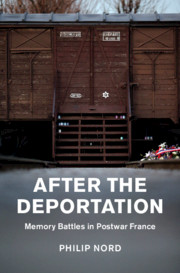Book contents
- After the Deportation
- Studies in the Social and Cultural History of Modern Warfare
- After the Deportation
- Copyright page
- Dedication
- Contents
- Figures
- Acknowledgments
- Abbreviations
- Introduction
- Part I Heroes and Martyrs
- Part II Shoah
- 7 Holocaust
- 8 The Teaching of Contempt
- 9 Witnesses
- 10 Generation
- 11 “The Return of the Repressed”
- 12 Shoah
- Epilogue and Conclusion
- Notes
- Index
11 - “The Return of the Repressed”
from Part II - Shoah
Published online by Cambridge University Press: 16 November 2020
- After the Deportation
- Studies in the Social and Cultural History of Modern Warfare
- After the Deportation
- Copyright page
- Dedication
- Contents
- Figures
- Acknowledgments
- Abbreviations
- Introduction
- Part I Heroes and Martyrs
- Part II Shoah
- 7 Holocaust
- 8 The Teaching of Contempt
- 9 Witnesses
- 10 Generation
- 11 “The Return of the Repressed”
- 12 Shoah
- Epilogue and Conclusion
- Notes
- Index
Summary
Histories of Holocaust consciousness sometimes begin with a chapter on forgetting and silence. Yet, if there was not in fact silence (as the preceding chapters have tried to show), why were so many convinced that there had been one? Psychiatry had an explanation ready to hand. The psychic trauma of the Holocaust had led to a repression of memory, and, now in the 1970s and 1980s, that repressed memory was at last boiling to the surface, helped along, of course, by the exertions of a new generation no longer in thrall to the kind of obfuscating stories that Gaullists and Communists had once told. How this psychiatric template emerged in the French context owed much of course to the work of child psychologists like Claudine Vegh but also something to the literary experiments of Romain Gary, Patrick Modiano, and Georges Perec. All three adapted and played with the template, as did Gary in La Danse de Gengis Cohn (1967), Modiano in La Place de l’étoile (1968), and Perec in W ou le souvenir d’enfance (Paris, 1975).
- Type
- Chapter
- Information
- After the DeportationMemory Battles in Postwar France, pp. 339 - 354Publisher: Cambridge University PressPrint publication year: 2020



